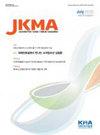息肉切除术后结肠镜检查监测策略:重点关注修订后的韩国指南
IF 0.3
Q3 MEDICINE, GENERAL & INTERNAL
引用次数: 0
摘要
背景:异时性晚期肿瘤的风险与初次结肠镜检查中息肉的存在有关。因此,在息肉切除术后建立一个适当的结肠镜监测期是至关重要的。当前概念:美国多协会工作组、欧洲胃肠内窥镜学会和英国胃肠病学学会在本世纪20年代修订了各自的国外指南。韩国于2022年公布了修订版息肉切除术后结肠镜监测,其危险因素如下:(1)腺瘤≥10mm;(2) 3 ~ 5个(或更多)腺瘤;(3)管状绒毛状或绒毛状腺瘤;(4)含高级别不典型增生的腺瘤;(5)传统锯齿状腺瘤;(6)无柄锯齿状病变,包含任何程度的发育不良;(7)至少10毫米大小的锯齿状息肉;(8) 3至5个(或更多)无柄锯齿状病变。在这些指南中,针对每个风险因素建议了适当的监测期。讨论和结论:支持息肉切除术后结肠镜监测最佳实践的证据已经加强,有助于支持对某些人群的密切随访和对其他人群的低强度随访。本文章由计算机程序翻译,如有差异,请以英文原文为准。
Strategy for post-polypectomy colonoscopy surveillance: focus on the revised Korean guidelines
Background: The risk of metachronous advanced neoplasia is linked to the presence of polyps on initial colonoscopy. Consequently, it is crucial to establish an appropriate colonoscopy surveillance period post-polypectomy.Current Concepts: The US Multi-Society Task Force, the European Society of Gastrointestinal Endoscopy, and the British Society of Gastroenterology revised their respective foreign guidelines in the 2020s. In Korea, a revised edition of post-polypectomy colonoscopic surveillance was announced in 2022, with the following risk factors: (1) adenoma ≥10 mm in size; (2) 3 to 5 (or more) adenomas; (3) tubulovillous or villous adenoma; (4) adenoma containing high-grade dysplasia; (5) traditional serrated adenoma; (6) sessile serrated lesions containing any grade of dysplasia; (7) serrated polyps of at least 10 mm in size; and (8) 3 to 5 (or more) sessile serrated lesions. In these guidelines, suitable surveillance periods are suggested for each risk factor.Discussion and Conclusion: The evidence supporting the best practices for post-polypectomy colonoscopy surveillance has strengthened, helping to support both close follow-up for some populations and less intense follow-up for others.
求助全文
通过发布文献求助,成功后即可免费获取论文全文。
去求助
来源期刊

Journal of The Korean Medical Association
Medicine-General Medicine
CiteScore
0.50
自引率
0.00%
发文量
84
审稿时长
4-8 weeks
期刊介绍:
The Journal of the Korean Medical Association (JKMA) is the official peer-reviewed, open-access, monthly journal of the Korean Medical Association (KMA). It contains articles in Korean or English. Its abbreviated title is ''J Korean Med Assoc''. The aims of the Journal include contributing to the treatment of and preventing diseases of public health importance and to improvement of health and quality of life through sharing the state-of the-art scientific information on medicine by the members of KMA and other national and international societies.
 求助内容:
求助内容: 应助结果提醒方式:
应助结果提醒方式:


